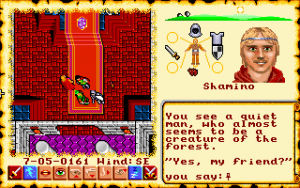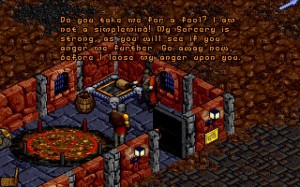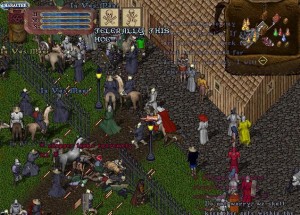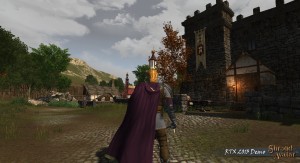Things were better before : the Ultima series
01
This article was published Dec. 29th, 2014, on LeBlogJeuVidéo.be, a french-speaking video game blog, and created by Yours Truly, co-authored by the incredible Washisama.
To celebrate the Early Access release of Shroud of the Avatar, I suggest you do a little retrospective of the series of games that inspired its founding genius to use the power of crowdfunding and bring us an updated version up to date. which represents one of the longest (note: … just like this sentence) series of role-playing games on computer, spanning almost three decades: the Ultima saga.
Ah! Ultima. Just like Star Wars soon, the world of video games also has its visionary genius, its triple trilogy, and its derivatives. And just like in Star Wars, there is food and drink. But where to start ?
It was in 1979 that a young student named Richard Garriott, discovering the magic of programming and a fan of role-playing games on paper, embarked on the creation of Akalabeth: World of Doom. Although very basic, this title then very inspired by Dungeons & Dragons, programmed in BASIC and with a perfectly generic story (as always we must save the world) allowed a player (on Apple II or even, mainframe) to travel a world fantastic on a top view map, and explore dungeons in first person view.
Ascension
The title, which since then is considered as a prequel to the main series and at the same time a seminal work of the role-playing on computer, was then only a rather mixed success because in a way published by Garriott himself . There wasn’t much of a story, but the foundations of the universe Garriott envisioned were already there. The real adventure began. And since the nine titles of the main series have such rich content, summarizing them here would do them an injustice, even if we will still give it a try.
The Ultima series comes in three main chapters, each represented by three games. Thus, Ultima 1-3 form the Dark Ages. The player, our hero, is called three times by Lord British. He will have to challenge three evil beings: Mondain the sorcerer, Minax, his companion in search of avenging his master, and finally Exodus, a creature half-man, half-machine, evil breed of Mondain and Minax. The game engine takes the basics of Akalabeth, top view for travel on the continent, first person view for dungeons.
Follow-up and solidification

If until then, the first three games followed the plot of the hero saving the universe, Ultima IV, the first chapter of the Age of Illumination, marked a drastic change in the mission. Subtitled “The Quest for the Avatar”, Lord British calls for the search for a hero who must unite the peoples of Sosaria, now called Brittania, after the traumatic events of the first three parts. Of course, the player will be this Avatar and will aim to find Enlightenment by taking the path of virtues and the first principles which are Love, Courage and Truth – a real initiatory journey in short. Ultima V will see the emergence of the corruption of these principles and virtues through the Shadowlords, and Ultima VI, the restoration of these values through a story in which we see the Avatar reconciling humans with a race until recognized. like demonic: the Gargoyles. The Age of Enlightenment will truly be the chapter where our hero becomes Brittania’s spiritual leader, an icon to follow.

Finally, we come to the Age of Armageddon. An evil being, the Guardian, will invade Sosaria and want to undo all that the Avatar has achieved so far. The Guardian is in fact the complete antithesis of the Avatar, a sort of tangible form on his evil side. Ultima VII was the most accomplished computer game of its generation. Already technically, it was light years from the sketchy graphics of early games, and it was the seminal work that introduced a lot of concepts that some current RPGs still follow. Group management, Complex inventory and “Paperdoll”, Night and day cycles, etc. Each non-player character has his agenda and goes about his business during the day. I remember that you needed a powerful computer to play it: at least an x386. The game itself was so big that it had to be split into two parts: The Black Gate and Serpent Isle. Moreover, all the Origin games (editor’s note: EA?) At the time pushed the capacities of our computers and posed real challenges just to make them run, because of a particular memory allocation system that really squeezed every single byte out of our ridiculous 512 kb of memory. In the end, having foiled the Guardian’s plans to conquer Brittania, he kidnaps the Avatar and deposits it in a new world where no one knows the Avatar: Pagan in Ultima VIII. Again, Garriott gives us a new isometric 3D engine, and the game becomes more action-oriented with some very irritating little platforming passages.
Downfall?

Unfortunately, this is where the series begins to decline. We are beginning to enter the era where the publisher dictates the release dates to make the best margins. Ultima VIII as well as its successor, Ultima IX: Ascension, were rushed to release on time, making them (upon release) unplayable, and even years later, ultimately shunned by quite a few fans. Yet, once again Garriott wanted to innovate: a new graphics engine for Ultima VIII, and downright the transition to a full 3D world for Ultima IX. But the damage was done. The badly finished games, a very sad end for a series which gave its letters of nobility to the genre. Especially Ultima IX, because even if the story remains faithful to the canons, we had more the impression of finding ourselves in a reboot than anything else. After the meticulously detailed world of Ultima VII, we could see that Origin had bet everything on the graphic aspect and not enough on the details that make the series happy.

Along with the main series, Ultima also declined in two sub-series: the Worlds of Ultima, leading our hero in a prehistoric world populated by dinosaurs on one side and on Mars in a Steampunk universe on the other side, and well on Ultima Underworld, the first 3D RPGs, one year before the release of Doom! Without forgetting Ultima Online, which was one of the first MMOs ever created, and which is still active, 15 years after its release. In short, a whole saga, which, even if it has aged badly, is one of the founding stones of the genre on computer. If I can’t advise you to play it in its entirety (because we’re talking about real time gulfs here) at least try Ultima VII. Even if it stings the eyes, the story is epic and any fan of PC RPG must have played it at least once.

Back to the present, Richard Garriott is launching via the crowdfunding Shroud of the Avatar, which is a sort of melting pot between all the concepts that the Ultima series has been able to introduce. Shroud of the Avatar offers an adventure that can be played solo or in multiplayer; it will be necessary to communicate with the NPCs either by typed commands or by clicking on keywords. Unlike classic MMOs, there aren’t any big question marks above the NPCs that give you the quests: you have to engage with them, and your journal will fill up with notes. At the same time, there is a fairly substantial crafting system. In fact, we can completely put aside the quests and just “live” your virtual life. In short, an online Skyrim (you see? The Elder Scrolls Online game that we didn’t really get …), all in the universe of Ultima. Still in alpha phase, the game promises to be extremely ambitious, there is still a lot to do but all the basic mechanics are there. And as a big fan of the series, if the promises are kept by Garriott et Co, that will make a new dream come true!